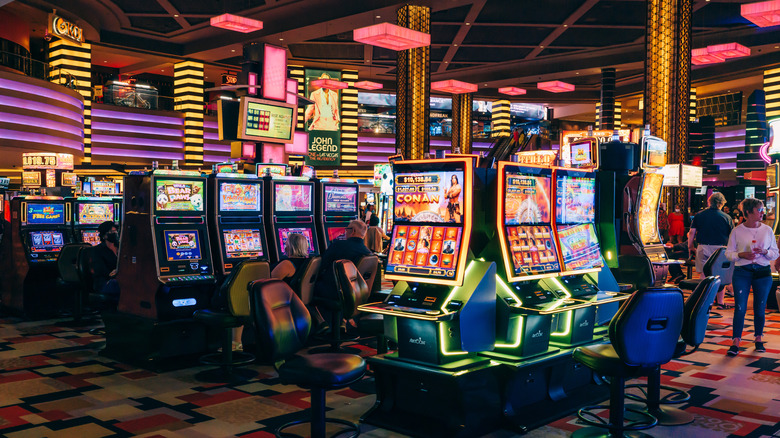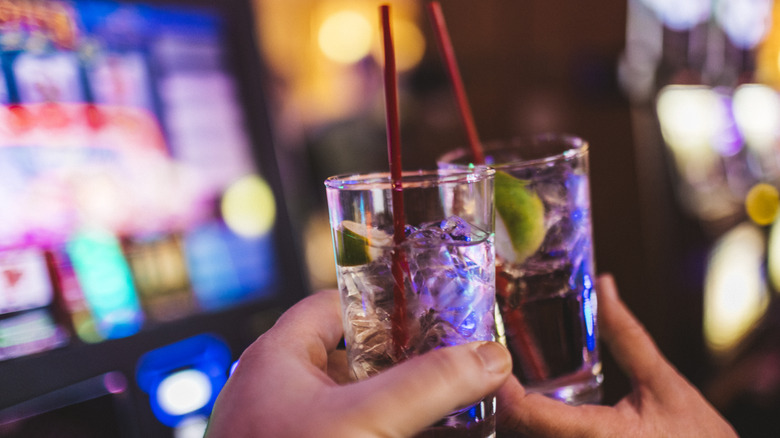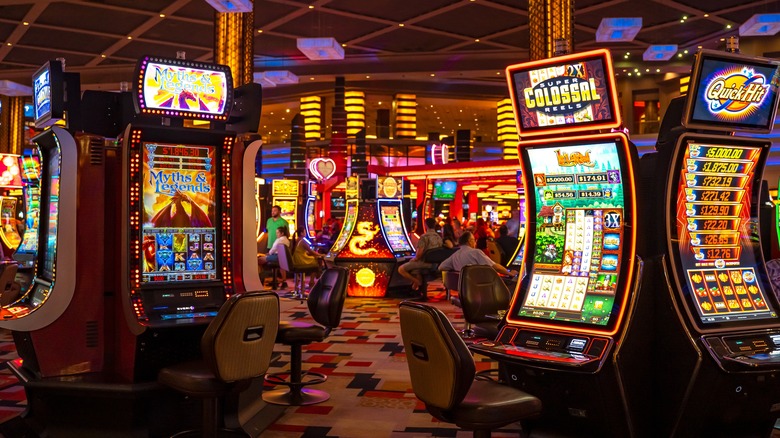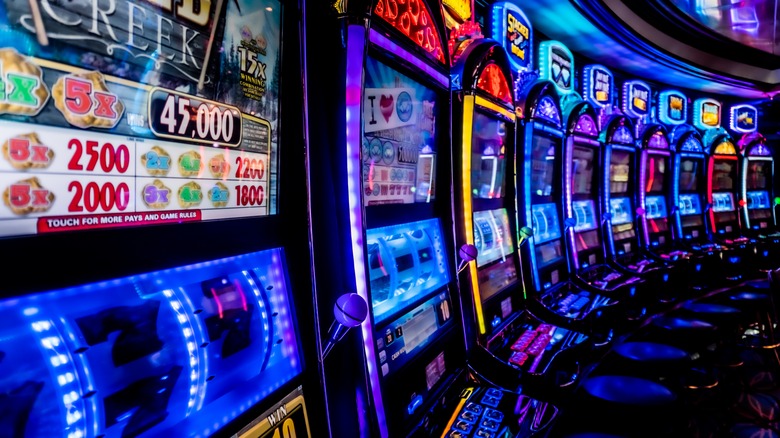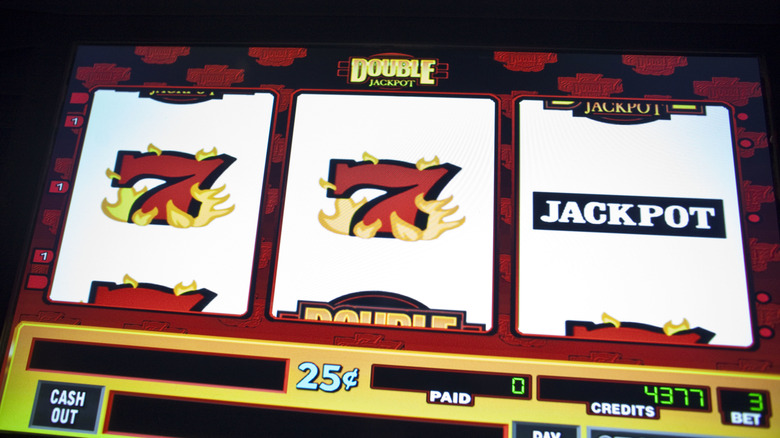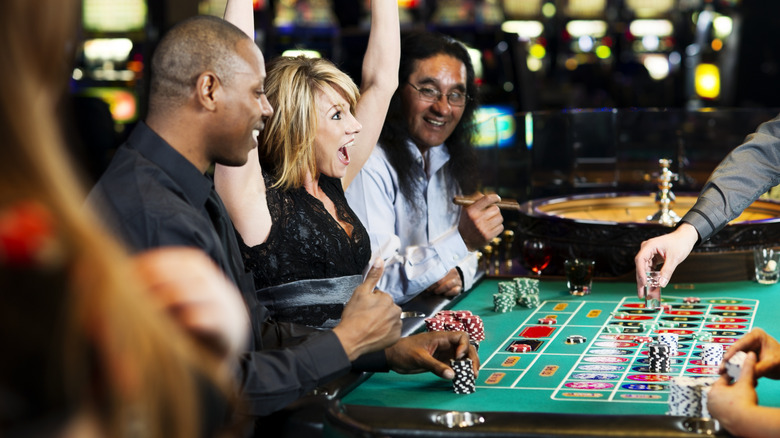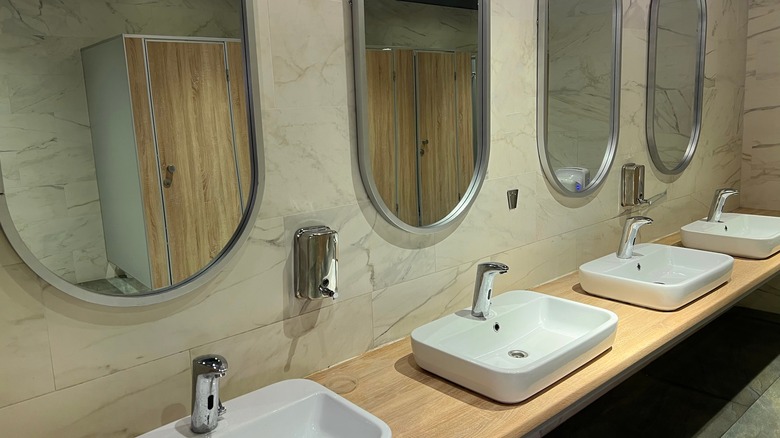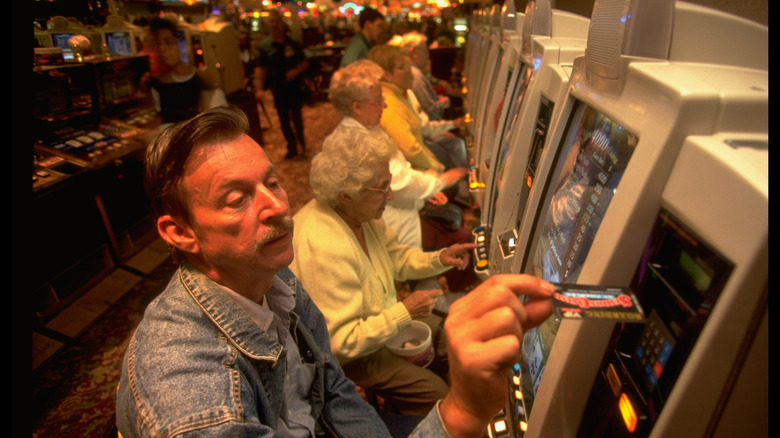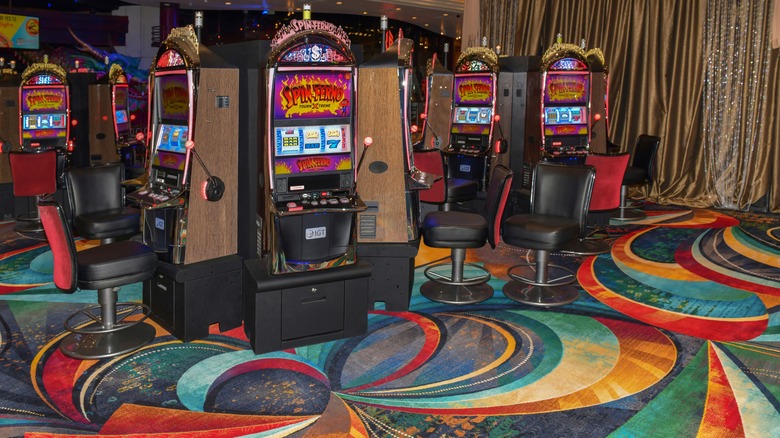Sneaky Ways Casinos Trick You Into Spending Money
Casinos offer a lifestyle that nearly anyone can attain, if only for an evening. The casino is a magical environment in which big winners bet it all to take on the house and walk away with insane riches. Movies like "Ocean's Eleven," "21," and "Focus" place gambling in a luxurious light. The characters showcase big personalities and the antics they find themselves caught up in make for compelling viewing. But beneath the façade of the big winner that's a brilliant bluffer or prodigious card counter, there lies a far less glamorous reality. In fact, a chronic gambling habit is actually a red flag that you should look out for — especially in a partner.
While some high rollers have created the persona of a consistently victorious gambler, most people entering the casino will leave with less money in their wallet than they walked in with. Casinos are built to relieve players of their money, and they do this to the tune of over $20 billion every year. The house is a relentless opponent, and while many patrons might understand that the odds aren't particularly in their favor, how a casino buoys its profitability and sinks the average player's potential winnings begins the moment the doors open. These tricks help tilt the odds even further in a casino's favor, and many are hiding in plain sight.
Casinos trade in their own currencies: Chips
The oldest trick in the book when angling to create a situation that incentivizes overspending is the use of unfamiliar currencies. In the same way that tourists often find themselves dishing out more cash than necessary when visiting a foreign country, casinos prey on the fact that the chips they use to place bets act as a foreign universe to the people using them. Casino chips act as a sort of "funny money" that recreational gamblers and those visiting the casino for a rare occasion aren't likely to trade back into dollars as they gear up to leave. This creates an easy atmosphere for overspending since the money you're playing with isn't real cash.
Similarly, the use of these tokens to facilitate betting makes it easier for a gambler to place large bets in card games and elsewhere without the same inhibitions that might act against this sort of behavior when risking real dollars. Also, the chips you used to play with aren't generally transferable for use in other gambling establishments, making for a situation where you'll have to actively decide to change your chips back into dollars if you want to go elsewhere. All of these barriers that divorce players from reminders that they're gambling with true currency make it easier to spend, significantly benefiting the casinos in the process.
They dilute your sense of time
Another trick used across the board is the masking of time. When sitting in the office, commuting, or even going for a run or exercising at the gym, most people have a decent understanding of what time it is and how long they've been doing whatever it is they're engaged in. This helps maintain a sense of reality and is an integral part of the way people budget their time and manage the things they have on their schedule. But when you enter a casino, you won't see any clocks. You'll also lose sight of many other features that might otherwise help a person identify the time. Eliminating indications of the time creates a partial timelessness inside the casino. The result is a space that sees people stay on the gambling floor for longer than they may have anticipated.
By breaking down a person's natural sense of the time, casinos can pull customers in for lengthy gambling sessions that end up giving the establishment more opportunities to part gamblers with their money. As a result, anytime you go to the casino it's a good idea to wear a watch. This way, you won't have to rely on your phone — which requires you to keep it charged and physically take it out of your pocket — and can simply glance down at your wrist to gauge how long you've been playing.
Windows are nonexistent in the gaming hall
In addition to a lack of clocks, casinos won't showcase windows, either. Windows provide a view of the outdoors that lies beyond the casino. Designers want to keep gamblers' focus and attention solely within the confines of the gaming hall. Any view that allows them to see what's going on beyond it can act as a distraction that stops them from spending money. Instead, there is no natural light in a casino and everything a gambler sees is illuminated by brightly colored artificial lighting matched up with buzzers, alarms, and other sights and sounds that keep attention on the machines and tables.
Cutting windows out of the equation serves another purpose. In addition to masking what's going on outside the casino, the lack of windows limits players' natural ability to gain information about what time of day it is. In conjunction with the missing clocks, masking the amount of sunlight outside the casino's walls helps keep gamblers actively engaged for longer periods.
Casinos are often heavy handed with the free alcohol
Drinking is known to induce poor decision making skills. There's no question over whether this is fact or fiction, and casinos know it too. It's for this reason the casinos are often quick to offer free drinks to people playing on their floors. The more you drink the more you'll loosen up and lean into the good time that you're experiencing with friends, colleagues, or even as an individual popping in for a few games. But with this added jovial outlook comes the likelihood that you'll spend even more money than you may have planned to.
Casino patrons might even be tempted to come in for the free drinks and stay for a few hands of blackjack, reckoning that any losses incurred at the table will hopefully offset the cost of a few rounds of drinks. But it's easy to end up becoming engrossed in the game or even migrating from the blackjack table to slot machines or elsewhere. While slippery slopes may appear far less frequently than people give them credit for, this one is surely a downhill trajectory to watch out for.
Casino floors are typically laid out like mazes
Casinos don't only rely on savvy odds and tricky decorative styles to keep you engaged in the gambling environment. Casinos themselves are built from the ground up to confuse the people who frequent them. The layout of a casino floor often resembles some kind of a maze. Rather than showcasing straight lines and easy-to-follow rows that will lead you from one part of the casino to the next in a relatively linear fashion, casinos are laid out so that people have to walk the farthest distances possible to get from one thing to the next. These layouts then showcase a variety of options that attempt to catch your attention as you snake your way through the floor.
This strategy is deployed primarily as a means to keep bathrooms, exits, and even cash-out cages in somewhat confusing locations. If you can't see the exit, you're not likely to be actively thinking about leaving without some type of provocation. The maze-like interior helps minimize a gambler's thoughts surrounding anything other than placing a bet or playing a slot machine.
The casino creates ample opportunities for you to spend money
Throughout the warren of a casino's layout, the designers will place as many opportunities for you to spend money as possible, working to put them directly in your path as you move through the space. Whether you're looking for the exit, trying to find friends who may have wandered off, or are seeking someone to refill your glass, casinos pack in a truly mystifying volume of spending opportunities.
But machines and tables aren't the only things that work to separate you from your money. Flashing lights, inviting sounds, and the carnival-esque landscape create a sense of opportunity and work to try to fill you with thoughts of winning. The goal is to create a sense that if you just play that one machine over there you might walk out with a big payday. The opportunity cost seems low and the potential feels sky-high. This emotional response is the casino's sneaky design tricks at work and it's often very effective.
They advertise huge jackpot sums
In addition to flashing lights and all the other hallmarks of fabulous potential prizes, casinos shamelessly advertise gigantic jackpot signs. Sometimes these include cars or even commodity items like gold bars or other shiny valuables, but they could just as easily come in the form of a huge cash payday. The idea here is to create a similar kind of response that entices people to play the lottery when the pool grows to an astronomical figure. Many people won't play the lottery regularly but figure it's worth buying a ticket that only costs a couple of bucks when the potential winnings reach up into the hundreds of millions or even billions of dollars. You can't fault someone for thinking this way, because that one ticket could change countless lives if the draw works out just right. However, while someone will eventually win the huge prizes offered by both the lottery and casino jackpot pools, the likelihood of that being you is virtually nonexistent. This doesn't stop people from trying, and casinos have found great success in the use of massive prizes with microscopically slim odds.
It's worth noting where the lottery and casinos diverge on this point. Casinos set their prizes while lottery winnings rollover. If a casino is offering a car as its jackpot, it's because the management knows that the allure of the prize will yield a higher profit than the cost of the vehicle, otherwise, it wouldn't be there.
Casinos focus everyone's attention on big winners
In the event that someone does win a major payout while playing in the casino, the establishment makes sure that everyone in the building knows exactly where that lucky winner is located. Rather than shying away from the huge "loss" that this winning spin will create on the books, casinos highlight the fact that someone has just walked away with a potentially life-changing total. Many casinos will blare sirens, flash an array of lights, and even blast confetti into the air or drop balloons to mark the occasion. This spectacle tends to drag on for quite a long time.
The result is a casino full of other players who, however irrationally, believe that they may have a shot at winning the next jackpot if they just keep playing. In reality, a winner today creates a string of losers directly in their wake. Casinos are in the business of making money, and big payouts are intimately linked to the house odds. Most people lose money most of the time, that's just the way the gambling business works. By focusing everyone's attention on a big winner, casinos can temporarily mask the fact that most of the time, players and slot machine pullers will lose.
Bathrooms are found in the bowels of the building
Another layout trick that casinos use to artificially condition gamblers to continue playing is the location of bathrooms. In a typical restaurant or office building, bathrooms will generally be found near exits or elevators. This makes them convenient for patrons who are on their way in or out. This design feature also places the bathroom in an area that's somewhat separated from the main usage space. The result is a comfortable restroom that doesn't interfere with the routine activities that take place inside the establishment.
Casinos opt for a different design language, however. Instead of placing bathrooms near the exits, casinos hide them all the way in the back of the building. You may even have to walk around in circles to find a restroom as a result of the gaming floor's labyrinth of machines and passageways. The aim here is to keep areas that have nothing to do with gambling separated from the exit. This is yet another exercise in psychologically conditioning players to remain in the casino and engaged with its entertaining money-making tools for as long as possible. Also, by placing bathrooms far out of the way, casinos double down on their ability to saturate gamblers with opportunities to risk their money as they make the long walk through its floor layout.
ATMs are strategically located next to the highest earning machines
If you see an ATM in a casino, there's a good chance that everything located around it might lose you money at an exponential clip. Casinos have been known to strategically place ATMs next to tables and machines that operate as their highest earners. This arrangement has been carefully constructed so that people engaged in lucrative gambling practices that net the casino the best profits won't have to travel very far to top up when they run out of cash.
This feature induces a unique behavior in the gambling space. By placing the ability to get more funds with ease next to popular tables and machines, gamblers who think that if they just keep playing the odds they'll even out their losses are incentivized to stay on the same game for longer. Rather than walking across the casino and finding a new place to play, gamblers can take out a bit of cash and get right back into gaming where they were and without much hesitation. The phenomenon vaguely resembles the countdown to insert more coins and continue an arcade game once your character has run out of lives.
Oxygenation induces energy, and casinos use it as a secret weapon
Another unique trick that casinos rely on to create a lucrative gambling space is the use of oxygen. Pumping oxygen into the room is an underrated trick of the trade. As a gambler, you may not notice the change in atmosphere when you walk into a casino, but your body language and behavior will certainly be altered. Enriching the air inside a casino with oxygen creates a space where gamblers are more alert and in a much better mood. Not only are gamblers wired when inhaling oxygen-enriched air, staving off the effects of sleepiness that would otherwise set in across a long gaming session, but the improved mood helps reduce the sense of fatigue and frustration that tends to accompany the financial setback of mounting losses.
This strategy is unique in that gamblers aren't likely to notice that they're being subjected to added oxygenation. Even if other strategies don't fully register as profit-seeking ploys, you'll surely notice that the bathroom is far away or that the layout is confusing. But the fact that you don't know you're being subjected to this manipulative secret makes it perhaps the most cunning on the entire list.
The ridiculous carpets actually serve a purpose in keeping players more alert
Finally, that classic casino carpet is actually leveraged as a money-making strategy, too. The ridiculous carpets that feature prominently in casinos aren't just installed in deference to some sort of historical trend. Instead, the loud and obnoxious carpet pattern beneath your feet is a carefully calculated assault on your senses. It's a choice purpose-built to keep you from looking down. Even if your eyes or your posture does droop to the floor for an extended period, the brazen color pattern won't allow your brain and eyes the subtle rest that comes when looking at a neutral feature. These attention-grabbing carpet patterns manifest a physical response in which people remain engaged with their environment rather than slumping in their chairs or leaning against something and zoning out to give the mind time to think and rest.
The ever-so-slight nudge to maintain an erect posture increases stamina in the people playing the slots or betting at tables. The more alert and awake you are, the less likely you are to think about leaving, so even the floor is actively participating in the project of enriching the casino at your expense.



